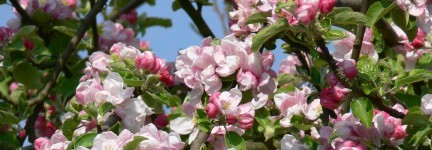Order, Beauty, and Harmony
Part
1

Rows of pear, apple, and cherry trees in white and
pink blossoms under a cloudless blue sky, the orchard was in full bloom. Bees buzzed from one flower to the next
gathering nectar. Sun rays reflected from a nearby pond surface and ducks basked in the warmth of the spring
morning. A tabby cat explored the grassy meadow, looking for mice. Poplar trees, dressed in fresh green foliage,
swayed gently in the breeze. Recent swallow arrivals returned to their old nests or were busily building new ones,
and a blackbird sang heartily. The stork had returned to her old nest on the chimney top and surveyed the
breathtaking scene.
Chance or Design?
At some point in the distant past, the universe, including planet Earth and all that
is on it, came into being. No one knows exactly when and how, but humans marvel at its complexity, diversity,
order, and beauty. Ponder, for example, the adaptation of organisms to existing conditions, the complex functions
taking place with infinite precision, and the delicate balance in nature (only relatively recently disrupted by
human activities).
Considering the intricacy of just one cell is astounding. When one takes into
account that millions of cells form the numerous organs performing hundreds if not thousands of functions in a
living creature, it becomes mind-boggling. Multiply this further by the number of species comprising land, sea, and
air creatures (including all insects and microorganisms). Add to this the interdependence of all living things and
the factors affecting environment and climate, as well as the enormously vast and complex universe beyond our
planet (in comparison to which the Earth is like a speck of dust).
Indeed, the natural world is awe-inspiring. Even in today’s scientific
and technological world, much about the mystery of life is not understood. While not an absolute proof in
themselves, the above-mentioned phenomena in their incredible intricacy and complexity provide evidence to support
the biblical account of a Being of supreme wisdom and intelligence who designed and created all that exists. When
all is taken into consideration, the probability of everything evolving without design or forethought, by mere
coincidence or blind chance, becomes infinitesimal. Some have stated that in reality more faith is needed to
believe in evolution than in the existence of a Creator God.
Laws of
Conservation
Everything visible operates according to
principles of law, order, and conservation, and is therefore predictable. Species beget offspring in their own
likeness, and seeds germinate into the plants or trees they came from. Life cycles continue predictably from birth,
via maturing and reproduction, to death. Energy and matter are conserved through natural cycles - for example,
water, carbon, and nitrogen cycles. Living organisms absorb elements from the air or soil, use them as building
blocks or for fuel, and excrete them again, thus returning them into the environment. Cells change continually,
being renewed, but also aging. Everything is interconnected. A delicate balance and harmony are essential for the
proper functioning of all aspects of life. Whenever the order and balance are disrupted, most often because of
human destructive activities frequently motivated by selfishness and greed, problems result. These may manifest
themselves, for example, in upset weather, natural disasters, physical disease, mental illness, relational
problems, and premature death.
Clocks and Internal
Programs
The universe is like an intricate time machine
with myriads of clocks regulating innumerable activities. The Earth, for example, turns around its axis every 24
hours and around the sun every 365¼ days. The sun and moon rise and set according to preset timers. Seasons come
and go with their associated weather patterns. Tides go in and out with regularity.
The animate world also abounds with evidence of inbuilt clocks. For example,
swallows migrate thousands of kilometers before winter. They leave their European nesting grounds at the same time
every year, fly to the same destination in Africa, and return again in the spring to where they came from. Salmon
also have astounding migratory habits built into their life cycle. They hatch and spend their early life stages in
fresh water. In their second year, they swim down the river to the ocean where they grow to adult size. Toward the
end of their life, between ages four and seven, the fish make a journey of several thousand kilometers across the
ocean, back to the river estuary where their life began.
Flowers start blossoming at
more or less the same time each year. Likewise, fruit ripens and leaves fall according to an inner timing. Young
animals and human babies leave the womb after predictable periods of time that are the same for all members of the
species. Birds know how long to sit on their eggs and what to do when the eggs hatch. They understand how and when
to teach their young to fly and to prepare them for life - be it in a local area or surviving long migratory
journeys.
Within the bodies of humans and of other creatures, all organs work
together without the control or even awareness of their “owners”. In “social” species, such as ants, bees, wolves,
and geese, there is order and cooperation, each group member knowing its role and tasks for the benefit and
preservation of the others. All functions are predictable, occur in a timely way, and follow internal programming
or instinct.
© 2006 Eva Peck
(continued)
|


 Facebook
Facebook Twitter
Twitter Digg
Digg Stumbleupon
Stumbleupon